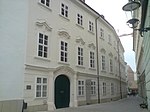Primate's Palace, Bratislava
18th-century architecture in SlovakiaBuildings and structures completed in 1781Neoclassical architecture in SlovakiaNeoclassical palacesPalaces in Bratislava

The Primate's Palace (Slovak: Primaciálny palác) is a neoclassical palace in the Old Town of Bratislava the capital of Slovakia. It was built from 1778 to 1781 for Archbishop József Batthyány, after the design of architect Melchior Hefele. In 1805, the Palace's Hall of Mirrors saw the signing of the fourth Peace of Pressburg, ending the War of the Third Coalition. Today, it serves as the seat of Mayor of Bratislava.
Excerpt from the Wikipedia article Primate's Palace, Bratislava (License: CC BY-SA 3.0, Authors, Images).Primate's Palace, Bratislava
Primaciálne námestie, Bratislava Bratislava (District of Bratislava I)
Geographical coordinates (GPS) Address Nearby Places Show on map
Geographical coordinates (GPS)
| Latitude | Longitude |
|---|---|
| N 48.144166666667 ° | E 17.109444444444 ° |
Address
Primaciálne námestie
Primaciálne námestie
811 01 Bratislava, Bratislava (District of Bratislava I)
Region of Bratislava, Slovakia
Open on Google Maps









